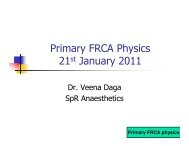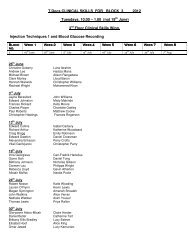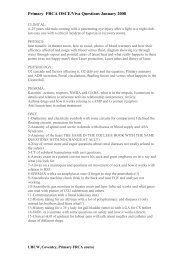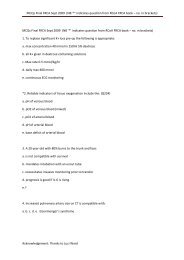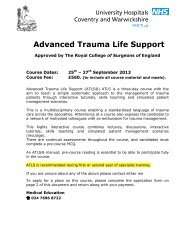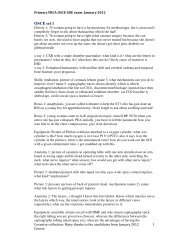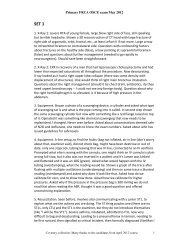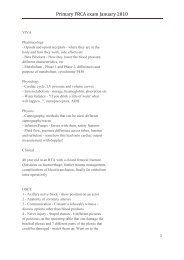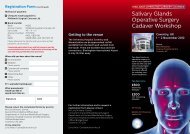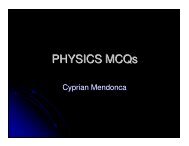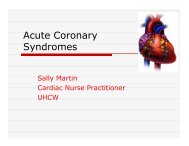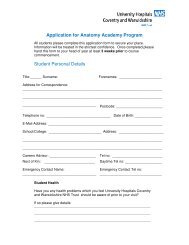Acute poisoning and overdoses - MEDICAL EDUCATION at ...
Acute poisoning and overdoses - MEDICAL EDUCATION at ...
Acute poisoning and overdoses - MEDICAL EDUCATION at ...
You also want an ePaper? Increase the reach of your titles
YUMPU automatically turns print PDFs into web optimized ePapers that Google loves.
10<br />
Management of <strong>Acute</strong> Poisoning <strong>and</strong> Overdose<br />
E Powell<br />
<strong>Acute</strong> <strong>poisoning</strong> is a common emergency th<strong>at</strong> presents to the accident <strong>and</strong> emergency<br />
(A & E) department <strong>and</strong> to intensive care. P<strong>at</strong>ients may be unconscious <strong>at</strong> the time of<br />
present<strong>at</strong>ion <strong>and</strong> appropri<strong>at</strong>e history may not be available. Poisoning may be<br />
accidental, i<strong>at</strong>rogenic or may be due to suicidal intention. The majority of the p<strong>at</strong>ients<br />
are young, otherwise medically fit <strong>and</strong> they will recover with basic supportive care.<br />
These p<strong>at</strong>ients are initially assessed <strong>and</strong> managed in A&E. They may require<br />
admission to intensive care for following reasons<br />
• Altered level of consciousness<br />
• Respir<strong>at</strong>ory failure<br />
• Cardiac arrhythmias<br />
• Cardiac conduction disturbances resulting A-V block<br />
• Hypotension<br />
• <strong>Acute</strong> renal failure<br />
Drug overdose may occur through several routes: oral, inhaled, skin contact or<br />
intravenous. The following are the most commonly consumed poisons.<br />
• Industrial or agricultural chemicals<br />
• Household products<br />
• Plant <strong>and</strong> animal toxins, fumes<br />
• Recre<strong>at</strong>ional drugs: Amphetamines, Ecstasy<br />
Following are the most commonly consumed drugs.<br />
• Paracetamol<br />
• Tricyclic antidepressants (dothiepin, amitriptyline)<br />
• Salicyl<strong>at</strong>es (aspirin)<br />
• Opioids (codeine, morphine, diamorphine)<br />
• Amphetamines, cocaine, ecstasy<br />
• Benzodiazepines (diazepam, temazepam)<br />
General principles of management<br />
Drug overdose should always be considered in an unconscious p<strong>at</strong>ient. Assessment<br />
<strong>and</strong> resuscit<strong>at</strong>ion should go side by side. General principle of management involves<br />
assessment, resuscit<strong>at</strong>ion <strong>and</strong> diagnosis of specific poison. In circumstances where<br />
p<strong>at</strong>ient is unable to provide history, contacting rel<strong>at</strong>ives or general practitioner may<br />
provide useful inform<strong>at</strong>ion.<br />
• Resuscit<strong>at</strong>ion using ABC (airway, bre<strong>at</strong>hing <strong>and</strong> circul<strong>at</strong>ion) approach.<br />
• Identific<strong>at</strong>ion of type of overdose, type of drug <strong>and</strong> amount<br />
• Limiting the absorption of drug<br />
• Enhancing the elimin<strong>at</strong>ion of drug<br />
Warwick Medical School- H<strong>and</strong>book of Anaesthesia 2006 1
• Specific tre<strong>at</strong>ments <strong>and</strong> antidotes<br />
• Continued supportive care of A,B,C<br />
• Psychi<strong>at</strong>ric review if deliber<strong>at</strong>e overdose<br />
Resuscit<strong>at</strong>ion: ABC<br />
The airway should be assessed <strong>and</strong> managed using basic airway manoeuvres <strong>and</strong><br />
simple adjuncts. High flow (10-15 l/min) of oxygen should be administered using<br />
facemask with reservoir bag. The respir<strong>at</strong>ory r<strong>at</strong>e <strong>and</strong> tidal volume should be assessed<br />
to rule out hypoventil<strong>at</strong>ion. For the following situ<strong>at</strong>ions definitive airway management<br />
using orotracheal intub<strong>at</strong>ion may be required.<br />
• Loss of airway due to reduced conscious level (GCS < 9/15, responsive to pain<br />
only on AVPU scale: A [alert] V [response to Verbal comm<strong>and</strong>s] P [response<br />
to Pain] U [Unresponsive].<br />
• Unprotected airway due to reduced conscious level (GCS < 9/15, AVPU-Pain)<br />
• Loss of airway due to seizures<br />
• Airway oedema due to smoke inhal<strong>at</strong>ion (CO <strong>poisoning</strong>)<br />
Bre<strong>at</strong>hing problems<br />
• Reduced respir<strong>at</strong>ory r<strong>at</strong>e or volume (sed<strong>at</strong>ive drugs, depressed conscious level)<br />
• Increased respir<strong>at</strong>ory r<strong>at</strong>e or volume (salicyl<strong>at</strong>e <strong>poisoning</strong>)<br />
• Aspir<strong>at</strong>ion of gastric contents (depressed conscious level)<br />
• Direct lung damage due to certain agents (irritant gases)<br />
All of the above problems require senior help <strong>and</strong> may require admission to ICU.<br />
Circul<strong>at</strong>ory problems<br />
• Hypotension- myocardial depression, peripheral vasodil<strong>at</strong>ion.<br />
• Hypertension (amphetamines).<br />
• Arrhythmias-bradycardias, tachycardias, abnormal rhythms, irregular rhythms<br />
(tricyclics, beta blockers, digoxin, lithium).<br />
Management of circul<strong>at</strong>ory problems includes intravenous access <strong>and</strong> fluid<br />
resuscit<strong>at</strong>ion. Hypotension <strong>and</strong> low cardiac output may require invasive monitoring<br />
<strong>and</strong> inotropic support. Hypertension should be controlled using anti-hypertensives<br />
(glyceryl trinitr<strong>at</strong>e infusion).<br />
Identific<strong>at</strong>ion of type of overdose (type <strong>and</strong> amount of drug)<br />
This will involve accur<strong>at</strong>e history from the p<strong>at</strong>ient, rel<strong>at</strong>ives <strong>and</strong> paramedics. Often<br />
cocktail of drugs <strong>and</strong> alcohol are consumed by the p<strong>at</strong>ient. The p<strong>at</strong>ient’s usual<br />
medic<strong>at</strong>ions, previous history <strong>and</strong> previous hospital admissions are likely to reveal the<br />
possible drugs th<strong>at</strong> might have been consumed by the p<strong>at</strong>ient.<br />
Clinical examin<strong>at</strong>ion<br />
Warwick Medical School- H<strong>and</strong>book of Anaesthesia 2006 2
• Drowsiness or sed<strong>at</strong>ion- alcohol, opioids, benzodiazepines, tricyclic<br />
antidepressants (TCAs)<br />
• Pupil: mydriasis- TCA’s, cocaine, ecstasy; miosis- opioids, organophosph<strong>at</strong>es<br />
• Tachypnoea- salicyl<strong>at</strong>es, carbon monoxide<br />
• Hypoventil<strong>at</strong>ion- sed<strong>at</strong>ive drugs<br />
• Bradycardia- digoxin, beta blockers<br />
• Tachycardia- cocaine, TCAs<br />
• Wide QRS <strong>and</strong> dysrrythmias- TCA’s<br />
• Seizures- TCAs, theophylline<br />
• Cherry red skin- carbon monoxide <strong>poisoning</strong><br />
• Hypothermia- sed<strong>at</strong>ive drugs<br />
• Hyperthermia- salicyl<strong>at</strong>es, amphetamines, cocaine, ecstasy<br />
Investig<strong>at</strong>ions<br />
• Plasma <strong>and</strong> urine toxicology<br />
• Blood tests to identify electrolyte abnormalities, derangement of acid/ base<br />
balance <strong>and</strong> organ damage.<br />
• ECG to detect changes in PR interval, QRS length, rhythm, r<strong>at</strong>e<br />
• Chest X ray: only useful when pulmonary oedema or aspir<strong>at</strong>ion is suspected.<br />
Specific advice regarding management can be obtained from regional poisons centre<br />
via internet or telephone<br />
Limiting the absorption of drug<br />
• Gastric lavage- inserting NG tube <strong>and</strong> aspir<strong>at</strong>ing gastric contents.<br />
-lavage with tepid w<strong>at</strong>er.<br />
-only useful if done within one hour of ingestion.<br />
-airway should be protected if conscious level decreased.<br />
• Emesis- no longer routine practice<br />
• Activ<strong>at</strong>ed charcoal -binds to the drug in the stomach so it is not absorbed<br />
-only effective in first hour after ingestion<br />
-can be given in repe<strong>at</strong>ed doses to increase elimin<strong>at</strong>ion of<br />
some drugs from the blood (e.g. digoxin)<br />
Enhancing the elimin<strong>at</strong>ion of drug<br />
• Forced diuresis- infusing fluids to increase urine output <strong>and</strong> therefore<br />
increasing elimin<strong>at</strong>ion of the drug.<br />
• pH manipul<strong>at</strong>ion-altering pH of urine to increase elimin<strong>at</strong>ion of the drug.<br />
Alkalis<strong>at</strong>ion of urine enhances the excretion of acidic drugs such as salicyl<strong>at</strong>es<br />
<strong>and</strong> phenobarbitone. Acidific<strong>at</strong>ion of urine enhances the excretion of alkaline<br />
drugs such as amphetamines.<br />
Warwick Medical School- H<strong>and</strong>book of Anaesthesia 2006 3
• Haemodialysis is useful for drugs with low protein binding <strong>and</strong> small volume<br />
of distribution.<br />
Specific tre<strong>at</strong>ments <strong>and</strong> antidotes<br />
Paracetamol (Acetaminophen)<br />
• Often no symptoms or signs.<br />
• 150mg/kg can be f<strong>at</strong>al.<br />
• Causes hep<strong>at</strong>ocellular necrosis in overdose due to s<strong>at</strong>ur<strong>at</strong>ion of metabolic<br />
p<strong>at</strong>hways <strong>and</strong> exhaustion of glut<strong>at</strong>hione stores.<br />
• Replenish glut<strong>at</strong>hione with methionine (oral) or N-acetyl cysteine (iv).<br />
• Tre<strong>at</strong> according to nomogram. N-acetyl cysteine should be given if serum<br />
paracetamol level is more than 200mg /L <strong>at</strong> 4 hrs, 100mg/L <strong>at</strong> 8 hrs or 50mg/L<br />
<strong>at</strong> 12 hrs of ingestion.<br />
• Liver function, cre<strong>at</strong>inine, INR <strong>and</strong> blood gas analysis should be performed if<br />
the present<strong>at</strong>ion is delayed.<br />
• P<strong>at</strong>ient should be transferred to specialist unit if there are signs of cerebral<br />
encephalop<strong>at</strong>hy, INR >2.0, presence of acidosis <strong>and</strong> renal impairment.<br />
Sed<strong>at</strong>ive drugs<br />
• P<strong>at</strong>ients who have taken opioids or benzodiazepines (BZD) in overdose are<br />
likely to present with a depression of cardio-respir<strong>at</strong>ory function <strong>and</strong> a reduced<br />
level of consciousness<br />
• Initial aims are to support ABC<br />
• Specific antidotes can be used (naloxone for opioids, flumazenil for BZD)<br />
Carbon Monoxide (CO)<br />
• P<strong>at</strong>ients with CO <strong>poisoning</strong> may have other injuries (e.g. burns).<br />
• Symptoms <strong>and</strong> signs rel<strong>at</strong>e to hypoxaemia.<br />
• Cherry red colour of mucous membranes.<br />
• Carbon monoxide has a much higher affinity for haemoglobin than oxygen.<br />
Hence it reduces the oxygen delivery to body tissues.<br />
• Tre<strong>at</strong>ment is ABC followed by high flow oxygen, reduces the half life of<br />
carboxyhaemoglobin.<br />
• Hyperbaric oxygen is sometimes used. This increases the dissolved oxygen in<br />
blood so th<strong>at</strong> oxygen delivery is less dependent on Hb <strong>and</strong> also reduces the<br />
half life of carboxyhaemoglobin.<br />
Tricyclic antidepressants (TCAs)<br />
• These drugs have anti-cholinergic effects-dry mouth, dry skin, dil<strong>at</strong>ed pupils<br />
<strong>and</strong> tachycardia.<br />
• They produce a metabolic acidosis, wide QRS complex, prolonged PR interval<br />
arrhythmias, convulsions <strong>and</strong> coma.<br />
• Tre<strong>at</strong>ment of ABC<br />
Warwick Medical School- H<strong>and</strong>book of Anaesthesia 2006 4
• Activ<strong>at</strong>ed charcoal (if p<strong>at</strong>ient presents within 3-4 hrs)<br />
• Correction of acid base disturbance is fundamental.<br />
• Tre<strong>at</strong>ment of seizures with lorazepam/diazepam.<br />
• Often need supportive care on ICU.<br />
Salicyl<strong>at</strong>es<br />
• Aspirin is a weak acid<br />
• It uncouples oxid<strong>at</strong>ive phosphoryl<strong>at</strong>ion (therefore anaerobic metabolism<br />
predomin<strong>at</strong>es resulting in lactic acidosis)<br />
• Vomiting, dizziness, tinnitus, hyperventil<strong>at</strong>ion (early)<br />
• It produces mixed respir<strong>at</strong>ory alkalosis <strong>and</strong> metabolic acidosis.<br />
• Seizures, hypotension, heart block, coma (l<strong>at</strong>e)<br />
• Supportive management<br />
• Correct acid/base disturbance<br />
• Consider alkalinis<strong>at</strong>ion of urine to increase elimin<strong>at</strong>ion.<br />
• In severe <strong>poisoning</strong>, haemodialysis should be considered.<br />
Continued Supportive care of ABC<br />
This involves supporting the cardio-respir<strong>at</strong>ory system until the p<strong>at</strong>ient has recovered<br />
from the adverse physiological effects of the overdose. It can mean a period of<br />
ventil<strong>at</strong>ion <strong>and</strong> inotropic support on intensive care.<br />
Psychi<strong>at</strong>ric review<br />
For p<strong>at</strong>ients with possible intentional overdose a psychi<strong>at</strong>ric review should be<br />
requested. This should take place before the p<strong>at</strong>ient is discharged from hospital.<br />
Further reading<br />
T.E. Oh. Intensive Care Manual, 4 th Edn. London: Butterworth-Heinemann, 1997.<br />
Appleboam R. Emergency management of <strong>poisoning</strong>. Anaesthesia upd<strong>at</strong>e; 2004,<br />
(issue 18). http:// www.nda.ox.ac.uk<br />
RA Hope, JM Longmore, TJ Hodgetts <strong>and</strong> PS Rarakha. Oxford h<strong>and</strong>book of<br />
medicine. 3 rd Edn. Oxford University Press, 1993.<br />
Warwick Medical School- H<strong>and</strong>book of Anaesthesia 2006 5



